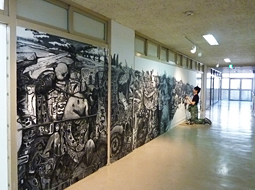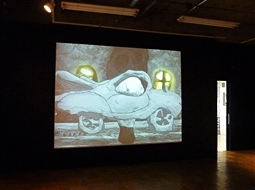 |
|
 |
| Atsuro Terunuma finalizing World in Microcosm (2010), a wall mural that envelops the former classrooms now occupied by Akibatamabi 21. |
|
Do You See It? (2009-present), one of two short animations by Atsuro Terunuma. |
It has been two months since the opening of 3331 Arts Chiyoda, the former junior high school building that has been given new life as a multidisciplinary community arts center near Akihabara. This month, two "classrooms" have been converted into Akibatamabi 21, an "alternative space" run by Tama Art University. The inaugural exhibition is a reunion for ten Tama alumni who, while students in 2005, created and ran their own exhibition space on the Hachioji campus. The intent was for the space to serve as an experimental exchange between different disciplines, allowing various forms of creative expression. The students themselves independently produced the exhibitions, a tradition that continues today. The founding members have all graduated and embarked on their own promising careers, but they have come back together to realize the vision for this new collaborative space with a show fittingly called A New Normal.
The two former classrooms that make up the Akibatamabi 21 gallery are now enveloped by a black and white mural by Atsuro Terunuma. Entitled World in Microcosm (2010), the fantastical illustration is a work still in progress. While stylistically sketchy and loose, the mural's technical execution is disciplined and sets the tone for the rest of the artwork on display. In the smaller of the two gallery spaces are nine pieces by four artists. Terunuma again flexes his animation muscles with two short films, Timeline (2008) and Do You See It? (2009-present), projected on one wall. Set to music, the monochromatic films have a captivating, stream-of-consciousness-like flow.
Adjacent to the animated films is the work of Tama University alum, photographer and performance artist Tetta (who uses only this name). The Sanjyusangendo Project (2010) is inspired by the 1001 Kannon Bodhisattvas of Sanjyusangendo temple in Kyoto. Three large-format portraits in the series represent Tetta's modern interpretation of Buddhist imagery through photography, Photoshop wizardry and high-resolution inkjet printing. The artist promotes community interaction by inviting visitors to have their faces photographed at one of the venue's weekly workshops. These headshots will then be transformed into modern Bodhisattva portraits until one thousand are collected.
In the larger of the two gallery spaces, sixteen pieces by the remaining six artists are on display. The works range from paintings and sculpture to video animation and mixed media installation. Although these are young, emerging artists, their work is mature and has substance. They are not easy to classify into one clear-cut genre. The Face Tag (2009) series of paintings by Tetsuya Chida may be considered surrealist. Migrant (2009) by Takumi Sanuki is an acrylic on wall-sized panel that appears to be a biological illustration. One struggles to identify the subject: is it a skeleton? a dinosaur bone or the fossil of an ancient sea creature? Another animal reference opposite Migrant is a whimsical cow's head found in The Ghost in Room 103 (2010), a mixed-media installation by Syogo Nojiri. The piece is playful and spontaneous if not slightly arbitrary. Finally, within a life-sized Monopoly-like house erected in the middle of the gallery, is a short animated film entitled The Woman Who Steals Fingers (2010) by Saori Shiroki. The fairytale storyline is more disturbing than "Hansel and Gretel," but the illustration style is ironically reminiscent of French impressionism.
Akibatamabi 21 is meant to be a venue for young artists to explore their potential and display their achievements. These emerging artists are already well on their way, as evidenced by the numerous group and solo exhibitions they have each participated in since graduating from Tama Art University. Through A New Normal, they have set out to promote free thinking, reject convention, challenge authority, and encourage each other out of their respective shells.
|